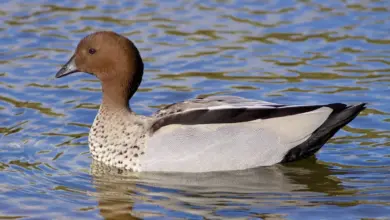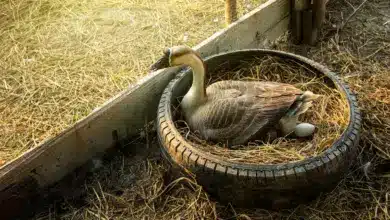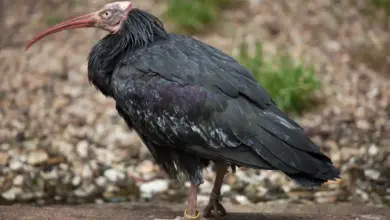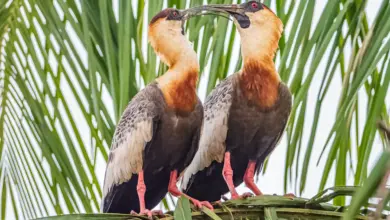The Hawaiian Geese (Branta sandvicensis) – locally also known as N?n?s — are the world’s rarest geese. They are believed to have been common on the Hawaiian Islands in the past, but aggressive hunting practices and predation by introduced mammals brought them close to extinction.
Thanks to conservation efforts, captive-bred birds have been successfully re-introduced into the Hawaiian Islands. Even though their numbers have been increasing, this species is still classified as Vulnerable.

The Nene is believed to have evolved from the Canada Goose that may have strayed off course during migration ~ 500,000 years ago.
Unlike other geese, Hawaiian Geese don’t need open water, however, they will swim if there is water near their nests.
Alternate (Global) Names
Chinese: ????? … Czech: Berneška havajská … Danish: Hawaiigås … Dutch: Hawaii gans, Hawaiigans, Hawaii-gans … German: Hawaiigans, Nene, Sandwichgans … Estonian: nenelagle … Finnish: Havaijinhanhi, nene … French: Bernache d‘Hawaii, Bernache des Île Sandwich, Bernache des Sandwich, Bernache d’Hawaï, Bernache néné, Oie Néné … Hawaiian: N?n? … Hebrew: ???? ????? … Italian: Nene, Ne’-ne’, Oca delle Hawaii … Japanese: hawaigan … Norwegian: Hawaiigås … Polish: bernikla hawajska … Russian: ????????? ??????? … Slovak: Bernikla vlnkovaná … Spanish: Barnacla Hawaiana, Barnacla nené, Ganso hawaiano … Swedish: Hawaiigås
Distribution and Habitat
The Hawaiian Goose or Nene is endemic to the Hawaiian Islands, where it historically occurred on the islands of Hawai?i, Maui, Kaho?olawe, L?na?i, Moloka?i, and Kaua?i.
Today, its range is restricted to Hawai?i, Maui, Moloka?i, and Kaua?i.
In Hawaii, it primarily occurs on the slopes of Mauna Loa, Kilauea (in and around Hawaii Volcanoes National Park), and Hualalai.
On Maui, the reintroduced population is currently centered in the Haleakala Crater area.
A growing population also occurs on the island of Kauai, where it inhabits lowland grass pastures.
This goose has also recently been reintroduced to the island of Moloka’i.
They are found in scrubland and grassland, on golf courses and sparsely vegetated slopes, on coastal dunes and lava plains, from sea level up to 7,900 meters (2,400 meters).
They are mostly sedentary (non-migratory), but some populations travel between lowland breeding grounds and montane foraging areas.
History
- 1800: This species is believed to have been common, with about 25,000 birds having occurred in the wild.
- Before 1890: The Nene is believed to have become extinct on Maui
- Captive populations have since been reintroduced on the islands of Maui (in 1962) and Kaua`i
- 1949: Captive breeding was started in Hawaii and by the Wildfowl and Wetlands Trust in England.
- 1952: Due to hunting and predation by introduced mammals, the Nene’s population was reduced to only 30 birds. At the time there was no protection for this species, and hunters would target vulnerable nesting birds, bringing this species close to extinction.
- In 1957, the Nene was adopted as Hawaii’s state bird.
- Between 1960 and 2006: Release of over 2,400 captive-bred birds on the islands of Hawaii, Moloka`i, Maui and Kaua`
- 1967: The Hawaiian Goose was listed as an endangered species under the Federal Endangered Species Act.
- 1963: The Hawaiian Goose Recovery Plan was published outlining the elements needed to achieve the goal of establishing 2,000 geese on Hawaii and 250 on Mau, which were to minimize the mortality rate in the wild, release of captive-bred birds, and to protect and improve their preferred habitat
- Total population estimates …
- 1999: 960 – 1,000 birds
- 2004: 1,241 birds based on counts in 2003 (USFWS)
- 2006: The total population was estimated to be 1,744 birds, of which 829 occurred on the island of Kaua`i, 360 on Maui, 74 on Moloka`i, and 481 on Hawaii (A. Marshall, D. Hu and K. Misajon in litt. 2007)
Due to some captive releases and predator control, the populations on Kaua’i have seen a slight increase; while the populations on the islands of Maui and Hawaii have remained steady, but partly dependent on continued captive releases.
Captive breeding and release efforts are implemented by the Maui Bird Conservation Center at Olinda and the Keauhou Bird Conservation Center on the Big Island. The State then releases young birds into protected habitats.
Approximately 2000 Hawaiian Geese are held in captivity in zoos and captive breeding facilities globally.
Threats
- The Nene’s decline in numbers was accelerated by …
- aggressive hunting of the birds during the breeding season, when nesting birds were most vulnerable;
- collecting of their eggs;
- predation by introduced mammals, such as Small Asian Mongooses, pigs, dogs and cats;
- One of the major current risks involve habitat conversation for agriculture, habitat alteration caused by exotic grasses and trees – all of which reduce the availability of suitable nesting sites and natural food sources for this species. The lack of nutrition results in starvation of young birds in particular, but also adults, as well as reduced breeding activities and successes.
- Modern threats include drought, inbreeding and diseases; as well as cars that commonly kill them in places where people feed them along the roadside.
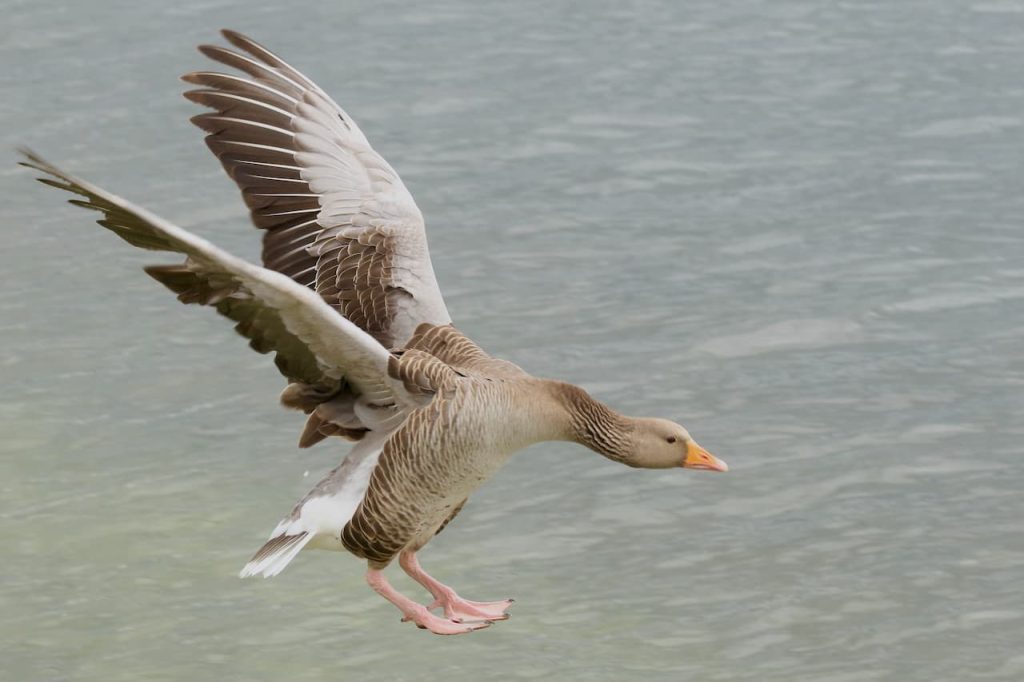
Description
The small, grey-brown Hawaiian Goose measures between 21 – 27 inches (53 – 69 cm) in length. The males weigh between 3.7–6.7 lbs (1.7 –3.1 kg) and the smaller females weigh between 3.4 – 5.6 lb (1.5 – 2.6 kg). The bill, legs and feet are black.
The Hawaiian Goose / Nene’s plumage shows a scaly pattern of grey, brown and white. It has a black head, yellow-buff / ochre cheeks and a golden-buff neck with black and whitish diagonal stripes, which are whitish feathers forming dark furrows against the black skin.
The Hawaiian Geese have evolved (physically adapted) to living in Hawaii by developing padding and reduced webbing on their strong feet to allow them to walk more easily on the rugged lava surfaces. All other goose species have completely webbed feet.
Gender ID: Males and females look alike, except for the female’s smaller size.
Juveniles resemble the adults, except for a duller brown plumage and less defined colors between the head and neck, with reduced striping and barring effects
Similar Species:
The Canada Goose is larger in size and can also be easily identified by its mostly black head and the broad white bar extending on the sides of the head and throat / chin.
The Brent Goose has entirely dark head, neck and chest.
Breeding / Nesting
The Hawaiian Geese have the longest breeding season (including nest construction, egg laying, and incubation) of any wild goose species – breeding from August to June. However, most breeding activities have been observed between November and January.
These geese are monogamous, and a pair typically remains together until one mate dies. Very rarely “divorces” happen, typically following an unsuccessful breeding season.
Unlike most other waterfowl, Hawaiian Geese mate on land.
The females alone choose the nesting site and prepare the nest, which is usually placed in hollows on the ground among vegetation – quite often, in a ‘kipuka’, which is an island of vegetation surrounded by barren lava. These nests are down-lined and generally well concealed under bushes. Females usually reuse the same nest.
A clutch consists of 1 – 5 eggs. The average on Maui and Hawaii is three eggs and four on Kaua?i. The female also incubates the eggs alone for 29 – 32 days.
Two to five white (usually 3) eggs are usually laid and the incubation period is about 30 days.
The hatchlings are able to leave the nest with the parents to feed within hours of hatching. The young are flightless for about 11 to 14 weeks after hatching, making them particularly vulnerable to predation. They are able to fly about 2.5 to 3 months after hatching. The young will typically remain with their parents until the following breeding season. These family flocks usually remain in the breeding grounds for about a month after the young are able to fly and then wander off to better feeding areas.
Calls / Vocalizations
The Hawaiian Goose was named “Nene” by the local for its call made in flight or when approached, which sound like ah-AHRK or a drawn-out NAY-nay. It also makes a muted ‘moo‘ sound that resembles the “moo” of a cow; and loud “honk”” calls – which are similar to those of the Canada Goose. Sometimes, kip-kip-kip-kip sounds can be heard.
Lifespan
The Hawaiian Geese can live up to 24 years in captivity. In the wild, they may live up to 20 years, but the average lifespan of wild birds is about 8 years. They reach reproductive age when they are about 3 years old, sometimes as early as two.
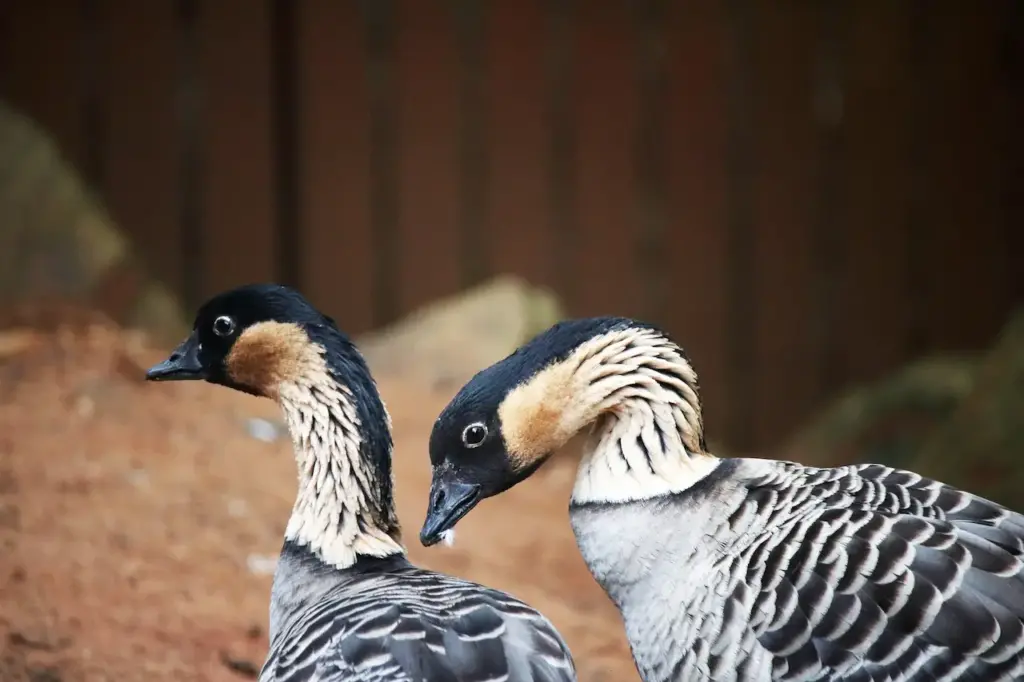
Diet / Feeding:
The Hawaiian Geese are herbivores that feed on leaves, seeds of grasses and herbs, fruit, buds, and flowers of grasses and shrubs.
They are grazers or browsers (depending on available food sources) and are typically associated with lava field vegetation.
They don’t appear to need fresh water as most of their dietary water intake need is met via the consumption of berries, but will take water when available.
Captive geese will typically feed on bird chow and vegetables, as well as grass and herbs that grow in their enclosure.
Feeding Ducks and Geese …
We all enjoy waterfowl and many of us offer them food to encourage them to come over and stay around – and it works! Who doesn’t like an easy meal!
However, the foods that we traditionally feed them at local ponds are utterly unsuitable for them and are likely to cause health problems down the road. Also, there may be local laws against feeding this species of bird – so it’s best to check on that rather than facing consequences at a later stage.
- Foods that can be fed to Ducks, Geese and Swans to survive cold winters and remain healthy when food is scarce in their environment.
Please note that feeding ducks and geese makes them dependent on humans for food, which can result in starvation and possibly death when those feedings stop. If you decide to feed them, please limit the quantity to make sure that they maintain their natural ability to forage for food themselves – providing, of course, that natural food sources are available.

